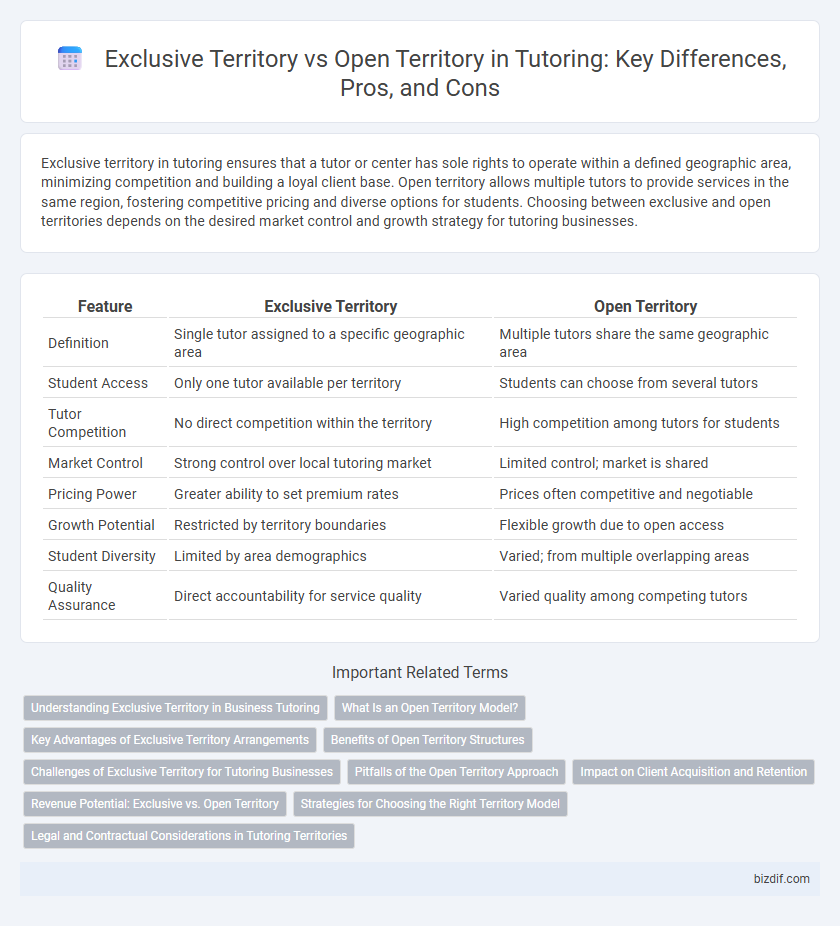Exclusive territory in tutoring ensures that a tutor or center has sole rights to operate within a defined geographic area, minimizing competition and building a loyal client base. Open territory allows multiple tutors to provide services in the same region, fostering competitive pricing and diverse options for students. Choosing between exclusive and open territories depends on the desired market control and growth strategy for tutoring businesses.
Table of Comparison
| Feature | Exclusive Territory | Open Territory |
|---|---|---|
| Definition | Single tutor assigned to a specific geographic area | Multiple tutors share the same geographic area |
| Student Access | Only one tutor available per territory | Students can choose from several tutors |
| Tutor Competition | No direct competition within the territory | High competition among tutors for students |
| Market Control | Strong control over local tutoring market | Limited control; market is shared |
| Pricing Power | Greater ability to set premium rates | Prices often competitive and negotiable |
| Growth Potential | Restricted by territory boundaries | Flexible growth due to open access |
| Student Diversity | Limited by area demographics | Varied; from multiple overlapping areas |
| Quality Assurance | Direct accountability for service quality | Varied quality among competing tutors |
Understanding Exclusive Territory in Business Tutoring
Understanding exclusive territory in business tutoring involves recognizing the designated geographic or market area where a tutor or franchisee has sole rights to operate and offer services. This exclusivity prevents competition within the defined region, ensuring market control and potentially higher client retention and revenue stability. Effective management of an exclusive territory requires strategic marketing and tailored service approaches to maximize regional demand and brand presence.
What Is an Open Territory Model?
An open territory model in tutoring allows multiple tutors to operate and offer services within the same geographic area without exclusive rights, fostering competitive access to potential clients. This model increases student options and encourages tutors to differentiate their teaching methods and expertise to attract learners. Open territories often result in a more dynamic market with varied tutoring styles and pricing, benefiting both tutors and students seeking personalized educational support.
Key Advantages of Exclusive Territory Arrangements
Exclusive territory arrangements in tutoring provide tutors with protected geographic areas, minimizing competition and enabling focused client acquisition. This exclusivity fosters stronger relationships with students and schools, boosting retention and trust. Tutors benefit from increased market stability and the ability to tailor services to specific community needs.
Benefits of Open Territory Structures
Open territory structures in tutoring allow educators to reach a broader student base without geographic restrictions, enhancing market exposure and growth potential. These models promote flexibility in scheduling and resource allocation, leading to increased efficiency and responsiveness to diverse learning needs. Higher scalability and opportunity for cross-regional collaborations contribute to sustained revenue growth and brand strengthening.
Challenges of Exclusive Territory for Tutoring Businesses
Exclusive territory in tutoring businesses often restricts growth potential due to limited student access within defined geographic boundaries. This limitation hinders the ability to expand client base and adapt to varying demand across regions. Furthermore, exclusive territories may lead to stagnation if the local market saturates or if demographic shifts reduce the number of potential students.
Pitfalls of the Open Territory Approach
The open territory approach in tutoring often leads to increased competition, reducing client retention and making it harder to establish long-term relationships. Tutors may face challenges such as limited scheduling flexibility and inconsistent income due to overlapping service areas. This model can also dilute brand presence, as multiple tutors operate in the same market without exclusive rights.
Impact on Client Acquisition and Retention
Exclusive territory in tutoring restricts client acquisition to a specific geographic area, enhancing brand presence and increasing trust among local clients, which often leads to higher retention rates. Open territory allows tutors to serve clients across multiple regions, expanding the potential client base but potentially diluting personalized service and reducing client loyalty. Balancing territory exclusivity with market reach is crucial for optimizing client acquisition strategies and sustaining long-term retention in tutoring services.
Revenue Potential: Exclusive vs. Open Territory
Exclusive territories in tutoring offer higher revenue potential by minimizing competition, enabling tutors to command premium rates and attract a stable client base within a defined geographic area. Open territories often result in reduced market share and lower pricing power due to the presence of multiple tutors competing for the same students. Revenue growth in exclusive territories is more predictable and scalable, driven by brand loyalty and localized marketing efforts.
Strategies for Choosing the Right Territory Model
Choosing the right territory model in tutoring involves evaluating market demand and competition within exclusive and open territories. Exclusive territories limit service providers to a specific geographic area, enhancing brand control and reducing direct competition, while open territories allow multiple tutors to operate freely, increasing flexibility but potentially diluting market share. Strategies include analyzing local demographics, student population density, and competitor presence to optimize tutor assignment and maximize growth opportunities.
Legal and Contractual Considerations in Tutoring Territories
Legal and contractual considerations in tutoring territories involve clearly defining exclusive territory rights to prevent conflicts between tutors and agencies, ensuring non-compete clauses are enforceable within the designated geographic area. Open territory agreements grant tutors the freedom to operate without geographic restrictions but may lead to market saturation and client disputes. Contract terms must explicitly outline territorial boundaries, exclusivity duration, and dispute resolution mechanisms to protect both parties' interests and comply with local business regulations.
Exclusive territory vs open territory Infographic

 bizdif.com
bizdif.com